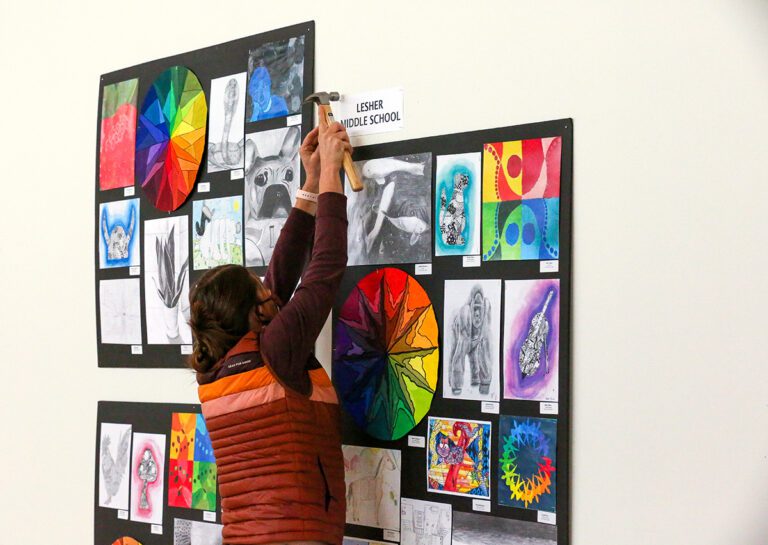Art teachers have a unique role in the culture of schools. We invite students to explore ideas and concepts and express themselves in a meaningful way. All of that happens in front of their peers, so we must be mindful to create a safe and trusting environment for all students in the art room. When students first step into your room at the start of a new semester, you may offer greetings, introduce yourself, and invite them to have a seat. First impressions and the ability to connect with an art teacher can have a lasting impact. For some students, introductions including names, nicknames, or pronouns help them feel welcomed into the art room right from the start.
Even if you aren’t starting a semester or quarter with a new group of students, taking a moment to educate yourself can be done at any time. Learning new information about how you can be more inclusive in your art room will help you, your current students, and your future students. If you are wondering if names and pronouns apply to your grade level, the American Academy of Pediatrics may give you some answers. In Coming Out: Information for Parents of LGBTQ Teens, the author shares an insight that “for many kids, gender identity becomes clear around puberty as they develop gender characteristics and stronger romantic attractions.” Supporting the diversity of all of your students at every age can encourage connection and acceptance and is proactive on your part.
In this article, we are going to be talking about how you can support your transgender and non-binary students in the art room with practical, introductory ideas.

As we continue this discussion, it is imperative to note that this can be a sensitive process for students and families.
Creating a safe and inclusive environment is a starting point not only for your students but also for their families. According to the American Academy of Pediatrics, “there is evidence that family members go through their own process of becoming more comfortable and understanding of a child’s gender identity, thoughts, and feelings.” This is a process that takes time and patience for all involved.
However, a transgender or non-binary student and their family may not be on the same page—the parents or caregivers may not approve or may be unaware. As such, you may find yourself in a situation where you are unsure how to communicate with family members about their student’s individual needs or circumstances. For further supports to ensure your students remain safe, ask for guidance from your school counselor, psychologist, and/or administrator. Also, be sure to adhere to your school or district’s policies and reporting procedures.
Positive communication can help build connections between school and home for your students, regardless of the circumstances. AOEU has a Pack called Parent Communication in PRO Learning to help you foster a positive rapport with your students’ families, including strategies for effective communication, handling difficult situations, and downloadable resources to respond to your students’ needs.
It is also important to make sure we are all speaking the same language. Some important words to know going into this conversation include:
- Trans*/Transgender: When referring to a larger group, trans* is used as a broader term. Transgender is a descriptive word for people who have or are undergoing a transition from their assigned sex at birth to that of the gender identity they feel on the inside.
- Deadname: A name no longer used by a trans person after transitioning. Deadnaming is the act of using that name against the person’s wishes.
- Transition/Transitioning: The process a transgender person undergoes when changing aspects of oneself, which may include one or more of the following: appearance, names, pronouns, or making physical changes to their body to more closely align with their internal sense of gender identity.
- Pronouns: A word that can replace someone’s name, such as she/her/hers, he/him/his, or they/them/theirs.
- PGPs: Preferred gender pronouns.
Here are six ways to foster an inclusive art environment for all students:
Art teachers of all grade levels strive to create welcoming and inclusive environments. One way to support belonging is to allow students to express their personal identities in their artwork if they so choose. If you are looking for ways to help support students in expressing their individuality, FLEX Curriculum can help. A few resources that support students in developing work about identity are Empowering Identity in Art, Portraits and Pencils, and Creating With Crayons. To give you a sneak peek at the Portraits and Pencils Collection, download the Who I Am vs. Who They See handout to assist your students as they dig deeper into their identity.
1. Be present.
When a student confides in you and sees you as their personal cheerleader, lean into that role. Listen with an open mind and a kind heart, nurture the relationship, and stand with them, not behind them.
2. Set the tone.
The art studio is a treasured place for your students. Consider introducing yourself with your pronouns at the beginning of a new course. Hanging a safe space sign in your classroom is thoughtful but is not a sustainable gesture for the rest of the year. It is important to set an inclusive tone and cultural climate of acceptance. You will need to consistently model appropriate behaviors and language and correct behaviors and conversations that discriminate against any student.
3. Build confidence.
Creating art can be personal and vulnerable. The art studio can be a safe space for young artists to explore inner thoughts, express their own ideas, and process all of the conflicts that may be stirring from within. Having the confidence to explore personal topics can be a big step. Listen to this episode of Art Ed Radio to help you boost your students’ confidence.
4. Practice patience.
When anyone changes a name, a time of transition occurs. Be patient with yourself when you are making efforts to fully adopt a student’s new-to-you name and pronouns into your vernacular. It takes time and practice to relearn something, but consciously make the effort.
5. Have hard conversations.
You are a leader in your community. Students regard you as a mentor who will respond fairly and without bias. When your colleagues or students approach you and question your support, challenge them to remember that, at the core of our profession, artmaking, relationships, and connection drive success, not our personal convictions. Going through experiences with any kind of transition for any student can be processed with art. At the end of the day, we are hired to teach art by supporting all students, not promoting personal beliefs.
6. Create art to learn names.
Designing artwork at the beginning of the school year or start of a new course can help you and your students learn each other’s names, nicknames, and pronouns. Try learning students’ names with name tents, fun activities about students’ interests from the Building Positive Relationships Pack in PRO Learning, or play games.

What else should you consider?
If you have a transgender or non-binary student in your art room, know that every student and situation is unique and complex. With that in mind, let’s briefly address three questions that may arise.
1. What if a student wants to be called something other than the name on your roster?
Deadnaming is using a name no longer used by a trans person after transitioning. It can be detrimental because a student may feel that the use of their deadname is a direct dismissal of their identity. If possible, it is critical to respectfully and intentionally leave the deadname in the past and move ahead to the future. Denying transgender students that opportunity can undermine their transition and trigger raw, painful memories from their past.
The National Center for Transgender Equality (NCTE) provides a thorough list of transgender students’ rights at school on their website. When addressing names, transgender students have every right to request that their school use the name and pronouns that align with their gender identity. The NCTE offers steps to take action against bullying and discrimination at school. Students are first encouraged to discuss the issue with school or district officials. If that does not yield favorable results, families can file a complaint with the U.S. Department of Education under Title IX. Undergoing a name change, whether or not it has been made official and legal, affirms the student as they move forward with their transgender transition. Using the correct pronouns is vital in this process too.
Your administration may give the directive to continue using a student’s birth name. In some cases, your administration may require a legal name change to use the new name. Learn more about transgender rights here to help support everyone involved.

2. What do I need to know about pronouns?
Pronouns are most often used when you are talking about someone without using their name. She/her/hers, he/him/his, and they/them/theirs are some of the commonly known pronouns and are sometimes connected with gender identity. The University of Wisconsin Milwaukee offers a guide to educate people about gender pronouns and states, “People who are limited by languages which do not include gender-neutral pronouns have attempted to create them, in the interest of greater equality.” Some examples include zie/zim/zir/sis/zieself. More examples can be found here.
Common pronouns have represented a person’s gender for a long time, but for some of our art students, pronouns can mean more than gender. When you respectfully use your students’ pronouns, you can avoid assuming gender expression. According to GLSEN’s Pronouns: A Resource, Supporting Transgender and Gender Nonconforming (GNC) Educators and Students, “By providing an opportunity for people to share their pronouns, you’re showing that you’re not assuming what their gender identity is based on their appearance.” Being cognizant and intentional about using correct pronouns can be a welcoming step towards a more inclusive classroom community.

Here are some mindful considerations to support learning names and pronouns:
- Intentionally and respectfully ask all of your students about preferred names or how to pronounce names.
- Introduce yourself by stating your name as you wish to be called, as well as giving your pronouns. This opens the invitation for others to self-identify and gives you accurate information.
- Be mindful to use preferred names and pronouns. Mark your roster, seating chart, and sub notes. You may consider making a disclaimer to the entire class that you will do your best to learn names, nicknames, pronouns, etc., but you also have a lot of students and may make a mistake.
- Invite students to correct you when you do make a mistake with their names, nicknames, and pronouns. Encourage students to correct you however they feel comfortable—privately or in the moment.
3. How do I navigate artwork with controversial content?
You may be hesitant to display artwork that contains controversial topics. Ray Yang, a former AOEU Writer and current National Art Education Association (NAEA) Director of Equity, Diversity, and Inclusion (ED&I) and Special Initiatives, wrote A Guide for Working With Students Creating Controversial Artwork, which can help you navigate this situation. In this article, Ray describes how to open the discussion with students, administration, and other school stakeholders. Ray also dives into how to develop guidelines for when something challenging arises regarding difficult artwork.
Supporting all of your students can be life-changing, both for you and your artists-in-training. Unlearning a deadname and pronouns may be challenging at first, but art teachers are experts at adaptability and perseverance. When you meet and learn new students’ names at the start of the next semester or quarter, consider using this time as an opportunity to cultivate a welcoming, inclusive, and safe art room for all.
Responding to the curiosity of students wanting to know more about the LGBTQ+ community may have you scratching your head. You may also be considering bringing awareness to LGBTQ+ artists by including them as a natural part of your curriculum. Luckily, AOEU has a number of resources for you to check out:
- Why We Should Include LGBTQ+ Artists in Our Classroom (Episode 121)
- 5 LGBTQ+ Artists You Should Know
- How to Be an Ally to Your LGBTQ+ Students
- 3 Ways Being a Vocal Ally Benefits Your Students
- Creating a More Inclusive Classroom (Episode 183)
- Why Transgender Representation in The Art Room Matters: Interview With Rae Senarighi
- Inclusivity for All Learners in the Art Room
How do you currently support your transgender and non-binary students?
How do you advocate for a safe and inclusive classroom for everyone?
Magazine articles and podcasts are opinions of professional education contributors and do not necessarily represent the position of the Art of Education University (AOEU) or its academic offerings. Contributors use terms in the way they are most often talked about in the scope of their educational experiences.







